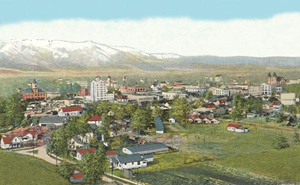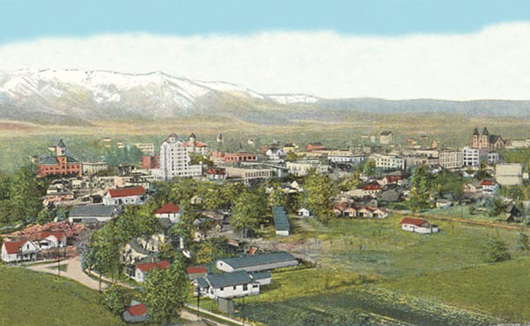
BAKER CITY, Ore. (AP) – Zella Sly is holding a stone that looks perfect for propping open a door that’s out of plumb.
Or you could use it to buy a new Ferrari.
This is, suffice it to say, not an ordinary rock.
To be geologically precise, it’s not even a rock at all.
It’s a chunk of nearly pure gold.
Specifically, the biggest, and most famous, gold nugget ever found in Oregon.
And it has a new home in Baker City.
Well, sort of new.
The Armstrong nugget, all 5 pounds of it, rests today where it has for more than half a century – in the U.S. Bank branch at 2000 Main St. in Baker City.
But the nugget, and the rest of the dazzling display of the precious metal that surrounds it, is shown off to better effect in a new wood-and-glass case.
The custom-built case not only looks nice, it incorporates much more sophisticated security features, said Sly, who manages the Baker City branch.
Despite the new precautions, though, the key to the old security system remains in place, Sly said.
“The gold is locked in the vault every night,” she said.
The gold collection was transferred to the new case on Friday morning, before the bank opened.
“We needed to up our game,” said Bob Kavanaugh, Eastern Oregon district manager for U.S. Bank. “This is a unique display, and very important to Baker County. We want the people of Baker County to understand that we take this very seriously.”
Kavanaugh credits Sly as the “driving force” behind the project to replace the display case for the gold collection.
Sly said she was surprised, when she took the job in Baker City about a year ago, by the popularity of the gold display and its centerpiece, the Armstrong nugget.
“I had no idea it was such a draw,” Sly said. “We have tour buses that stop just so people can see the display. We have school groups from Portland.”
A trio of Baker City Police officers supplied security while Tabor Clarke, who owns a Baker City jewelry store, weighed the collection.
His official figure for the Armstrong nugget was 80.33 ounces.
The rest of the collection, which includes smaller nuggets (the biggest weighs 14.1 ounces), flakes and dust, much of it given to the bank over the years, exceeds 150 ounces.
The actual value depends on the purity of each sample, Clarke said.
Due to its value as a unique collectible, Clarke said, unusually large pieces such as the Armstrong nugget might well fetch more than the market price of gold, which comes to $115,000 or so based on the nugget’s purity of about 87 percent and the current gold value of about $1,650 per ounce.
The Armstrong nugget was found, so the story goes, by a miner named George Armstrong in 1913 near Susanville, in Grant County.
The colorful – and, perhaps, apocryphal – tale has it that Armstrong was walking behind his son when he noticed the nugget in the muddy footprint left by his son’s boot.
Whether the story is precisely accurate or not, about the nugget there is no doubt.
You need only heft the thing – it’s as heavy as a normal stone three or four times its size – to understand that its pale yellow is no thin lacquer of paint.
Friday’s event at U.S. Bank included a guest of honor, Edna (Rogers) Harrell of Baker City.
“It’s a real honor to have Edna here,” Kavanaugh said.
Her father, John B. “Jack”’ Rogers, and her grandfather, John W. Stuchell, both served as leading officers in the First National Bank of Baker, the predecessor of today’s U.S. Bank (the Baker City bank merged with U.S. National Bank of Portland in 1959).
Stuchell bought the First National Bank of Baker in 1934 – the bank was founded in 1883 – and kept it operating throughout the Great Depression, said Harrell, who graduated from Baker High School in 1955 and from the University of Oregon in 1959.
Stuchell died on Sept. 22, 1947.
Harrell’s father, John B. Rogers, was elected as the bank’s president on Oct. 8, 1947. It was the largest independent bank in Eastern Oregon.
The Armstrong nugget had been on display at the bank since before the Depression, she said.
The late Jack Pittman, a former U.S. Bank official, said in a 2004 interview that George Armstrong stored his nugget at the bank for safekeeping, and borrowed hundreds of dollars using the nugget as collateral.
In 1955 Harrell was photographed standing next to the display case, along with Mary Ann Hansen, for a U.S. Bank postcard that touted the gold collection.
She also worked at the bank as a teller during her summer vacations.
She said her father had the idea to promote the collection, and in particular the Armstrong nugget, as a tourist attraction.
Harrell, 75, said her family’s link to Baker County’s mining legacy dates back one more generation. Her great-grandparents, J.B. and Mary Gardner, worked the French Diggins mine near Granite in the 19th century.
Every year for close to three decades, the couple would mine during the summer and bring their gold back to Baker by wagon in the fall.
“They were never once molested by bandits,” Harrell said. “Last year we went in on four-wheelers and found the place. I knew right where the buildings used to stand.”
___
Information from: Baker City Herald, http://www.bakercityherald.com/
Copyright 2013 Associated Press. All rights reserved. This material may not be published, broadcast, rewritten, or redistributed.
AP-WF-01-10-13 2331GMT
ADDITIONAL IMAGE OF NOTE



